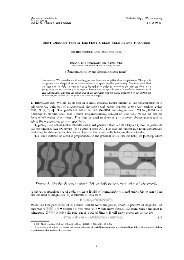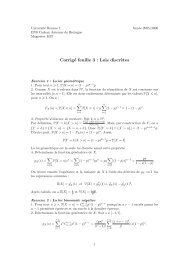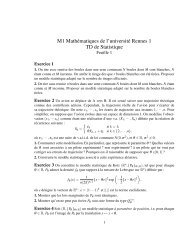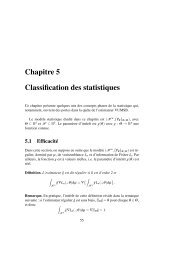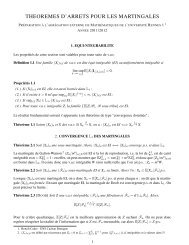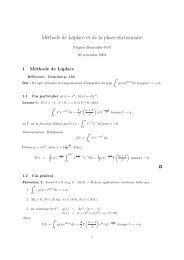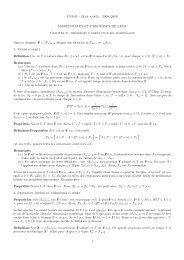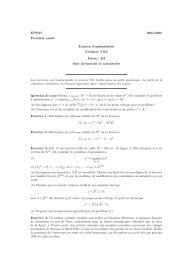Bath Institute For Complex Systems - ENS de Cachan - Antenne de ...
Bath Institute For Complex Systems - ENS de Cachan - Antenne de ...
Bath Institute For Complex Systems - ENS de Cachan - Antenne de ...
You also want an ePaper? Increase the reach of your titles
YUMPU automatically turns print PDFs into web optimized ePapers that Google loves.
for almost all ω ∈ Ω. The differential operators ∇· and ∇ are with respect to x ∈ D. Let usformally <strong>de</strong>fine, for all ω ∈ Ω,a min (ω) := minx∈Da(ω, x) and a max (ω) := max a(ω, x). (2.2)x∈DWe make the following assumptions on the input random field a and on the source term f:A1. a min ≥ 0 almost surely and 1/a min ∈ L p (Ω), for all p ∈ (0, ∞).A2. a ∈ L p (Ω, C t (D)), for some 0 < t ≤ 1 and for all p ∈ (0, ∞).A3. f ∈ L p∗ (Ω, H t−1 (D)), for some p ∗ ∈ (0, ∞].The Höl<strong>de</strong>r continuity of the trajectories of a in Assumption A2 implies that both quantities in(2.2) are well <strong>de</strong>fined, that a max ∈ L p (Ω) and (together with Assumption A1) that a min (ω) > 0and a max (ω) < ∞, for almost all ω ∈ Ω. We will here not make the assumption that we can bounda min (ω) away from zero and a max (ω) away from infinity, uniformly in ω, as this is not true forlog-normal fields a, for example. Many authors work with such assumptions of uniform ellipticityand boun<strong>de</strong>dness. We shall instead work with the quantities a min (ω) and a max (ω) directly.Note also that our assumptions on the (spatial) regularity of the coefficient function a aresignificantly weaker than what is usually assumed in the literature. Most other analyses of thisproblem assume at least that a has a gradient that lies in L ∞ (D). As we will see below, we coul<strong>de</strong>ven weaken Assumptions A1 and A2 and only assume that ‖a‖ C t (D) and 1/a min have a finitenumber of boun<strong>de</strong>d moments, i.e. 0 < p ≤ p a , for some fixed p a > 0, but in or<strong>de</strong>r not to complicatethe presentation we did not choose to do this.As usual in finite element methods, we will study the PDE (2.1) in weak (or variational) form,for fixed ω ∈ Ω. This is not possible uniformly in Ω, but almost surely. In the following we will notexplicitly write this each time. With f(ω, ·) ∈ H t−1 (D) and 0 < a min (ω) ≤ a(ω, x) ≤ a max (ω) < ∞,for all x ∈ D, the variational formulation of (2.1), parametrised by ω ∈ Ω, isb ω(u(ω, ·), v)= Lω (v) , for all v ∈ H 1 0 (D), (2.3)where the bilinear form b ω and the linear functional L ω (both parametrised by ω ∈ Ω) are <strong>de</strong>finedas usual, for all u, v ∈ H0 1 (D), by∫b ω (u, v) := a(ω, x)∇u(x) · ∇v(x) dx and L ω (v) := 〈f(ω, ·), v〉 H t−1 (D),H 1−t0 (D) . (2.4)DWe say that for any ω ∈ Ω, u(ω, ·) is a weak solution of (2.1) iff u(ω, ·) ∈ H0 1 (D) and satisfies (2.3).The following result is classical. It is based on the Lax-Milgram Lemma [18].Lemma 2.1. <strong>For</strong> almost all ω ∈ Ω, the bilinear form b ω (u, v) is boun<strong>de</strong>d and coercive in H0 1(D)with respect to | · | H 1 (D), with constants a max (ω) and a min (ω), respectively. Moreover, there existsa unique solution u(ω, ·) ∈ H0 1 (D) to the variational problem (2.3) and|u(ω, ·)| H 1 (D) ‖f(ω, ·)‖ H t−1 (D).a min (ω)The following proposition is a direct consequence of Lemma 2.1.Theorem 2.2. The weak solution u of (2.1) is unique and belongs to L p (Ω, H 1 0 (D)), for all p < p ∗.Proof. First note that u : Ω → H0 1 (D) is measurable, since u is a continuous function of a.The result then follows directly from Lemma 2.1, Assumptions A1 and A3 and from the Höl<strong>de</strong>rinequality.However, as usual in finite element methods we will require more (spatial) regularity of thesolution u to be able to show convergence. We will come back to this in Section 3.1. First let uslook at some typical examples of input random fields used in applications.4





